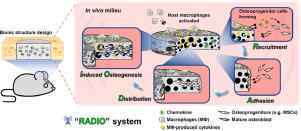Acta Biomaterialia ( IF 9.4 ) Pub Date : 2020-05-21 , DOI: 10.1016/j.actbio.2020.05.023 Yiming Niu 1 , Lintao Wang 2 , Na Yu 3 , Panfei Xing 1 , Zhenzhen Wang 1 , Zhangfeng Zhong 1 , Yanxian Feng 1 , Lei Dong 2 , Chunming Wang 1

|
Scaffolds for tissue repair are designed in an increasingly complicated manner to meet multi-facet biological needs during the healing process. However, overly sophisticated design, especially the use of multiple components and delivery of exogenous cells, hampers the bench-to-bedside translation. Here, a multi-functional – yet mono-compositional – bioactive scaffold is devised to mediate the full-range, endogenous bone repair. Based on immunoactivity screening, a chemically-modified glucomannan polysaccharide is selected and processed into an anisotropic porous scaffold, which accurately stimulates macrophages to produce pro-regenerative cytokines. These cytokines effectively enhance the recruitment (“R”) and induced osteogenesis (“IO”) of the bone progenitor cells in situ. Meanwhile, the anisotropic porosity and carbohydrate signal of the scaffold facilitate differential adhesion (“A”) and distribution (“D”) of the macrophages and bone progenitor cells – enabling the former's accumulation at the surface while encouraging the latter's infiltration into the scaffold. Implanted in a rat calvarial defect model, this “RADIO” system effectively promotes healing over 12 weeks, with the obvious formation of hard callus through the scaffold. In summary, RADIO integrates multiple functions into one single scalable system (“all-in-one”) to govern the dynamic bone-repair process, by harnessing the power of host macrophages. RADIO represents an open platform to solving the long-lasting complexity-versus-simplicity dilemma in biomaterials design.
Statement of Significance
Biomaterials as versatile tools for tissue repair are becoming increasingly complicated, yet overly sophisticated design – especially the use of multiple components, exogenous cells, and overdosed growth factors – hampers their clinical application. The pre-requisite for designing a successful integrative scaffold is to identify an inherent biological target responding to biomaterial signals, thereby efficiently and safely promoting tissue repair via the endogenous healing capability instead of extra multifarious biochemical components. For bone regeneration, the pivotal regulator is macrophages. Through activating host macrophages, our single-component scaffold system coordinates the entire bone regenerative cascade in situ and induces successful bone regeneration in a calvarial defect model. This scaffold represents a scalable and multi-functional approach to effectively simplify the sophisticated design in regenerative medicine.
中文翻译:

一种靶向巨噬细胞的“多合一”支架,可直接指导内源性骨修复。
用于组织修复的支架以越来越复杂的方式设计,以满足愈合过程中多方面的生物学需求。然而,过分复杂的设计,尤其是使用多种成分和外源细胞的递送,阻碍了从台到床的翻译。在这里,设计了一种多功能但单一成分的生物活性支架,以介导全方位的内源性骨修复。基于免疫活性筛选,选择化学修饰的葡甘露聚糖多糖,并将其加工成各向异性的多孔支架,该支架可准确刺激巨噬细胞产生促再生细胞因子。这些细胞因子有效地提高骨祖细胞的募集(“R”)和诱导的成骨(“IO”)原位。同时,支架的各向异性孔隙率和碳水化合物信号有助于巨噬细胞和骨祖细胞的差异粘附(“ A”)和分布(“ D”)–使前者能够在表面积聚,同时促进后者渗透到支架中。植入大鼠颅骨缺损模型中,此“ RADIO”系统可在12周内有效促进愈合,并通过支架明显形成硬hard。总之,RADIO通过利用宿主巨噬细胞的功能,将多种功能集成到一个单一的可扩展系统(“多合一”)中,以管理动态骨修复过程。RADIO代表了一个开放的平台,可以解决生物材料设计中长期存在的复杂性与简单性的难题。
重要声明
生物材料作为用于组织修复的通用工具正变得越来越复杂,但设计过于复杂(尤其是使用多种成分,外源细胞和过量的生长因子)阻碍了它们的临床应用。设计成功的整合支架的先决条件是识别对生物材料信号作出反应的固有生物靶标,从而通过内源性愈合能力而不是额外的多种生化成分有效而安全地促进组织修复。对于骨骼再生,关键调节剂是巨噬细胞。通过激活宿主巨噬细胞,我们的单组分支架系统可在原位协调整个骨再生级联反应并在颅骨缺损模型中诱导成功的骨再生。该支架代表了一种可扩展的多功能方法,可有效简化再生医学中的复杂设计。











































 京公网安备 11010802027423号
京公网安备 11010802027423号